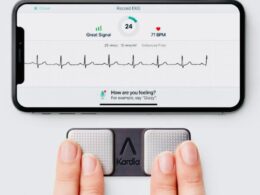Forbes
Frank McGillin, Forbes Technology Council
Oct 17, 2022,
Frank McGillin is the CEO of The Clinic by Cleveland Clinic.
Site Editor:
Joaquim Cardoso MSc.
health transformation — multidisciplinary institute
October 25, 2022
Introduction
With open enrollment (1) just around the corner, employers are looking for new ways to offer high-quality healthcare benefits at the lowest possible cost to their employees and their organization.
One of the most popular tactics? Implementing digital healthcare options into health benefits packages.
As cited in the Kaiser Family Foundation’s 2021 Employer Health Benefits Survey, …
… an overwhelming majority of employers (96%) offer telehealth as a benefit.
If we were talking pulse oximetry, a figure like this would show near-maximum saturation.
- But while 74% of employers believe in virtual care’s ability to transform care delivery,
- they also believe virtual care’s value lies beyond one-time visits for immediate care needs.
For example, 84% want telehealth to be more tightly integrated with in-person care, while 69% plan to incorporate virtual primary care into benefits packages by 2025.
… 84% want telehealth to be more tightly integrated with in-person care, while
69% plan to incorporate virtual primary care into benefits packages by 2025.
Entry Points For Care Management
Moreover, data suggests employees want more from virtual care than video visits for one-time needs, too.
Today, just 1 out of 5 companies reports telemedicine usage rates of at least 8%.
As digital health technology advances, so do opportunities for employers to expand virtual care capabilities for better care at lower cost while increasing engagement.
… data suggests employees want more from virtual care than video visits for one-time needs, too.
Here are three areas to consider:
Entry Points For Care Management
- Longitudinal Health Management
- Expanding Access To Specialized Expertise
- Going Beyond ‘One And Done’ Virtual Care (eg Virtual Second Opinion)
As digital health technology advances, so do opportunities for employers to expand virtual care capabilities for better care at lower cost while increasing engagement.

1.Longitudinal Health Management
When it comes to digital health, virtual doctor visits seem to get most of the press — understandably so.
Being able to visit a doctor through a webcam from the comfort of home or even from a private area at work is great for convenience.
But virtual care’s full potential goes beyond “lights, camera, action.” It’s also important to open healthcare’s “digital front door” toward services that help employees better manage their health.
This includes access to robust apps or patient portals where employees can find a doctor, make appointments, renew prescriptions, check test results, get advice on managing chronic conditions and more.
But virtual care’s full potential goes beyond “lights, camera, action.” It’s also important to open healthcare’s “digital front door” toward services that help employees better manage their health.
The best solutions make it easy for members to access their medical records securely and share them with primary and specialty care providers-even when records and providers are located in different health systems.
- This streamlines and facilitates co-management of care-which is especially important for people with chronic conditions, who “account for three-quarters of doctor’s visits and 9 out of 10 prescriptions.”
- They also ease the process of scheduling virtual care-since 43% of consumers are dissatisfied with their ability to do so digitally, according to a UnitedHealth survey -and finding information about a provider.
The best solutions make it easy for members to access their medical records securely and share them with primary and specialty care providers-even when records and providers are located in different health systems.

2.Expanding Access To Specialized Expertise
Comprehensive virtual care management doesn’t stop with digital apps or portals. It also encompasses patient monitoring.
More and more, synchronous and asynchronous patient monitoring-combined with artificial intelligence and machine learning capabilities-is taking center stage.
More and more, synchronous and asynchronous patient monitoring-combined with artificial intelligence and machine learning capabilities-is taking center stage.
- More than half of providers in a 2021 survey said they have recommended the use of smartphone and tablet apps to their patients to monitor and track their care,
- while another 36% have recommended smartwatches and other wearables capable of monitoring heart rhythm and rate, blood pressure, glucose levels and more.
Indeed, there’s a growing belief in the promise of remote patient monitoring to improve disease outcomes and lower treatment costs for payers, employers and employees.
It’s one reason why 65% of benefits executives for self-insured Fortune 500 companies expect the availability of remote patient monitoring for members to increase.
It’s one reason why 65% of benefits executives for self-insured Fortune 500 companies expect the availability of remote patient monitoring for members to increase.
Each year, 1 out of 10 patients with cancer, an infection or a major vascular event, such as a heart attack or stroke, are misdiagnosed.
Diagnostic errors related to breast cancer alone cost employers $4 billion a year.
As a result, more employers are facilitating access to virtual second opinions to help control costs.
It’s one reason why the market for second opinions in healthcare is expected to reach more than $10 billion by 2027.
It’s one reason why the market for second opinions in healthcare is expected to reach more than $10 billion by 2027.

3.Going Beyond ‘One And Done’ Virtual Care (eg Virtual Second Opinion)
Virtual second opinions make it easier for employees to access medical experts who specialize in their condition no matter where your employees are located.
This problem is exacerbated by the nationwide shortages of physician specialists across conditions.
They also ease travel demands for employees and dependents.
Some programs provide nurse liaisons who gather patients’ records on their behalf, send them to a specialist for review, schedule a video consultation, and arrange for reports to be sent to the patient and their local provider afterward.
For employees, virtual second opinions can reduce the stress of a complex condition by ensuring employees receive not just the correct diagnosis but also the right treatment plan.
It’s a benefit that offers peace of mind and protects employees’ health and their livelihood.
Virtual second opinions make it easier for employees to access medical experts who specialize in their condition no matter where your employees are located.

Building an assortment of virtual care options into healthcare benefits packages can help avoid instances where employees’ health conditions go unaddressed or are mismanaged or mistreated.
It also extends access to care and medical expertise wherever and whenever employees need it, improving employee productivity and satisfaction while bolstering engagement.
In 2022 and beyond, achieving virtual care’s full value for employees and employers demands a more comprehensive approach.
Do it soon. Open enrollment will be here before you know it.
In 2022 and beyond, achieving virtual care’s full value for employees and employers demands a more comprehensive approach.
Do it soon. Open enrollment will be here before you know it.
Originally published at https://www.forbes.com.
About the authors & affilliations:
Frank McGillin is the CEO of The Clinic by Cleveland Clinic.

(1) What is open enrollment?
An open enrollment period is a window of time that happens once a year — typically in the fall — when you can sign up for health insurance, adjust your current plan or cancel your plan.
It’s usually limited to a few weeks. If you miss it, you may have to wait until the next open enrollment period to make any changes.












